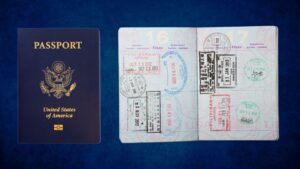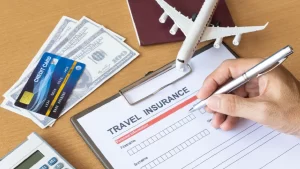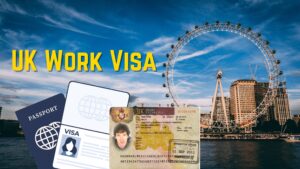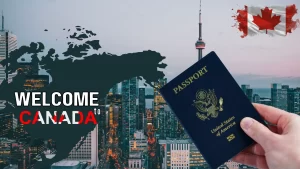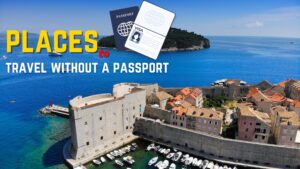Traveling internationally is an exciting experience, but the ability to visit different countries without a visa depends on the strength of your passport. Some passports offer visa-free access to numerous destinations, while others require travelers to apply for visas before departure. Understanding visa-free travel and passport rankings helps individuals plan trips more efficiently, avoid unexpected entry restrictions, and explore ways to enhance their global mobility.
This guide will explain visa-free travel destinations, how passport rankings are determined, and which countries offer the most travel freedom. It will also cover the benefits of holding a strong passport, the difference between visa-free, visa-on-arrival, and eVisa access, as well as strategies to improve travel flexibility. Whether you’re a frequent traveler, a business professional, or someone looking to expand your global reach, this article will provide valuable insights into how passport strength impacts international travel.
What is Visa-Free Travel?
Visa-free travel allows passport holders to enter a foreign country without obtaining a visa in advance. Travelers can visit the destination without going through the lengthy visa application process, making travel more convenient and accessible. Some countries allow entry without any additional documentation, while others may require a visa-on-arrival or an electronic travel authorization (eVisa). The level of access depends on diplomatic agreements between countries.
For example, a Japanese passport holder can enter more than 190 countries without a prior visa, while a passport from a lower-ranked country may require a visa for many destinations. The ease of travel depends on the strength of the passport, which is ranked based on its global access.
Understanding Passport Rankings
Passport rankings play an important role in determining a person’s ease of travel across international borders. A strong passport allows its holder to visit more countries without the hassle of obtaining a visa in advance, while a weaker passport may come with travel restrictions and lengthy visa processes. Various organizations evaluate and rank passports based on the level of access they provide.
What Determines Passport Strength?
A passport’s strength is measured by how many countries its holders can visit without needing a visa or by obtaining a visa-on-arrival. The main factors that determine passport strength include:
- Visa-Free Access: The number of countries a passport holder can enter without applying for a visa.
- Visa-on-Arrival Access: The number of countries where travelers can get a visa upon arrival without applying beforehand.
- eVisa Access: Some countries allow travelers to apply for an electronic visa (eVisa) instead of a traditional visa process.
- International Relations: Countries with strong diplomatic ties tend to have passports with greater global access.
- Security & Trustworthiness: Passports from politically stable and economically strong nations are often more trusted, leading to fewer visa restrictions.
Organizations That Rank Passports
Several global organizations track and rank passports based on travel freedom. The most recognized ones include:
- Henley Passport Index
- One of the most widely referenced rankings.
- Measures the number of destinations a passport holder can visit without a prior visa.
- Uses data from the International Air Transport Association (IATA).
- Global Passport Power Rank (Arton Capital)
- Ranks passports based on visa-free and visa-on-arrival access.
- Considers additional factors such as the Human Development Index (HDI) and economic strength.
- Nomad Passport Index
- Evaluates passports based on travel freedom, taxation policies, perception, and dual citizenship possibilities.
Each ranking system has its own criteria, but they all focus on measuring how easily a passport holder can travel internationally.
How Passport Rankings Are Calculated
Passport rankings are determined based on:
- Total Visa-Free Destinations
- Countries where the passport holder does not require a visa for entry.
- Visa-on-Arrival Destinations
- Countries where travelers can obtain a visa at the airport or border upon arrival.
- eVisa Accessibility
- Countries that require an electronic visa application but do not demand in-person appointments.
- Overall Travel Freedom Score
- A combination of visa-free, visa-on-arrival, and eVisa destinations to determine the final ranking.
For example, a Japanese passport consistently ranks among the strongest, with access to over 190 countries without a visa. In contrast, some passports, like those from Afghanistan or Syria, offer limited travel freedom, requiring visas for most destinations.
Passport rankings change over time due to international agreements, diplomatic relations, and geopolitical developments. Keeping track of these rankings helps travelers understand their mobility options and plan accordingly.
Top Visa-Free Travel Passports
A visa-free passport provides travelers with greater freedom, allowing them to visit multiple countries without the need for a visa or with minimal entry requirements. Some passports offer access to nearly 200 destinations visa-free, making international travel easier, while others face significant restrictions.
Countries with the Strongest Passports
The world’s most powerful passports belong to countries that have strong diplomatic relations, stable economies, and high levels of global trust. These passports allow their holders to travel visa-free or with a visa-on-arrival to most destinations worldwide.
As of 2024, the top-ranking passports include:
- Japan
- Singapore
- Germany
- France
- Italy
- Spain
- Finland
- South Korea
- Denmark
- Sweden
List of Passports with the Most Visa-Free Access
Based on the Henley Passport Index 2024, the passports with the highest global access are:
| Rank | Country | Visa-Free & Visa-on-Arrival Destinations |
|---|---|---|
| 1 | Japan | 193 |
| 1 | Singapore | 193 |
| 2 | Germany | 192 |
| 2 | Italy | 192 |
| 2 | France | 192 |
| 3 | Spain | 191 |
| 3 | South Korea | 191 |
| 3 | Finland | 191 |
| 4 | Denmark | 190 |
| 4 | Sweden | 190 |
| 5 | Netherlands | 189 |
| 5 | Austria | 189 |
These countries consistently rank high due to their strong diplomatic ties, allowing their citizens to travel with fewer restrictions.
Benefits of Having a Strong Passport
Holding a powerful passport offers several advantages, including:
- Hassle-Free Travel
- No need for time-consuming visa applications before traveling.
- Easier access to major travel destinations worldwide.
- Cost Savings
- Avoiding expensive visa fees and processing costs.
- Reducing the need for additional travel documents.
- Faster Border Clearance
- Shorter wait times at immigration and border controls.
- Access to automated entry systems in certain countries.
- More Business & Work Opportunities
- Easier access to job markets in multiple countries.
- No need for complicated work visa procedures in select nations.
- Flexibility & Spontaneous Travel
- Ability to travel on short notice without visa concerns.
- Increased opportunities for tourism, study, and relocation.
A strong passport provides its holder with unparalleled travel freedom, making international movement more convenient and cost-effective. This ranking system also encourages countries to strengthen their diplomatic relationships, leading to improved global mobility for their citizens.
Popular Visa-Free Destinations by Region
Visa-free travel varies by region, with some countries offering easy entry to travelers from certain nations. Depending on passport strength, tourists can explore stunning destinations without the hassle of obtaining a visa in advance. Below is a breakdown of popular visa-free travel destinations across different continents.
Europe (Schengen Countries, UK, etc.)
Europe is one of the most sought-after travel regions, with many countries allowing visa-free entry for passport holders from high-ranking nations.
- Schengen Area (26 countries, including France, Germany, Italy, and Spain) – Allows visa-free entry for many nationalities for up to 90 days within a 180-day period.
- United Kingdom – Offers visa-free entry for short visits to citizens of countries like the US, Canada, Australia, and Japan.
- Ireland – Allows visa-free travel for EU citizens and travelers from many Western countries.
- Switzerland & Norway – Though not part of the EU, they follow Schengen visa policies.
Asia (Thailand, Japan, Malaysia, etc.)
Asia is home to many visa-free travel destinations, especially for citizens of strong passport-holding countries.
- Japan & South Korea – Visa-free for many European, American, and Asian travelers for up to 90 days.
- Thailand – Offers visa-free or visa-on-arrival entry for citizens of over 60 countries, including the US, Canada, and most of Europe.
- Malaysia – Allows visa-free access for citizens from more than 60 nations for stays of up to 90 days.
- Indonesia (Bali) – Visa-free entry for 30 days for citizens of ASEAN countries and some other nationalities.
- Singapore – One of the easiest countries to visit visa-free, offering up to 90-day stays for many passport holders.
Americas (Caribbean Nations, South America)
The Americas, especially South America and the Caribbean, have many visa-free destinations for international travelers.
- Caribbean Nations (Barbados, Bahamas, Saint Kitts & Nevis, etc.) – Many Caribbean islands offer visa-free stays for up to 90 days to travelers from North America and Europe.
- South America (Argentina, Brazil, Chile, etc.) – Visa-free for most European and North American passport holders for 90 days.
- Mexico – Allows visa-free access to travelers from the EU, Canada, Japan, and other high-ranking passport countries.
- Costa Rica & Panama – Welcomes visa-free visitors from many European and American countries for up to 90 days.
Africa (Seychelles, Mauritius, etc.)
Africa has several tourist-friendly destinations that offer visa-free or visa-on-arrival entry.
- Seychelles – Allows visa-free entry for all nationalities, requiring only a visitor permit upon arrival.
- Mauritius – Offers visa-free access to travelers from over 100 countries for up to 90 days.
- Morocco & Tunisia – Visa-free for many European, Middle Eastern, and African countries.
- South Africa – Allows visa-free travel for citizens of the US, UK, and most of Europe for up to 90 days.
- Rwanda & Kenya – Offers visa-on-arrival or eVisa access for many travelers.
Oceania (Fiji, Micronesia, etc.)
The Pacific region consists of beautiful island nations that provide visa-free or visa-on-arrival access for many travelers.
- Fiji – Visa-free for citizens from over 100 countries for up to four months.
- Micronesia – Visa-free entry for US, EU, and several Asian countries for 30 days.
- Vanuatu – Allows visa-free access for many nationalities for up to 30 days.
- Samoa & Tonga – Visa-free or visa-on-arrival entry for many travelers from Europe, the US, and Australia.
Visa-free travel destinations make exploring the world easier for travelers with strong passports. However, it’s always essential to check entry requirements before planning a trip, as regulations may change over time.
Visa-Free vs. Visa-on-Arrival & eVisa
When planning international travel, understanding the differences between visa-free entry, visa-on-arrival, and eVisas is important. While some countries allow travelers to enter without any prior approval, others require a visa that can be obtained either upon arrival or through an online application.
Differences Between Visa-Free, Visa-on-Arrival, and eVisa
| Type | Description | Requirements | Examples |
|---|---|---|---|
| Visa-Free | Travelers can enter without applying for a visa. | Passport validity and proof of return ticket may be required. | Japan, Singapore, Schengen Area for eligible travelers. |
| Visa-on-Arrival (VoA) | Travelers get a visa at the airport or border upon arrival. | Payment of visa fees, completed forms, and sometimes proof of funds or accommodation. | Thailand, Maldives, Nepal, Egypt. |
| eVisa | A visa obtained online before travel, eliminating the need for embassy visits. | Online application, passport scan, and payment of processing fees. | India, Turkey, Kenya, Australia. |
- Visa-Free Entry: Offers the most convenience, as travelers do not need to apply for a visa before or upon arrival. This is typically granted to citizens of countries with strong diplomatic ties.
- Visa-on-Arrival (VoA): Requires travelers to complete paperwork and pay fees upon arrival at the destination country. While it is easier than obtaining a visa beforehand, it may involve long waiting times at immigration.
- eVisa: A digital alternative to traditional visas, where travelers apply online before departure. While easier than embassy visits, it still requires prior approval before traveling.
How Travelers Can Check Entry Requirements
Before traveling, it’s essential to check visa policies to avoid complications at immigration. Travelers can:
- Use Official Government Websites
- Many countries provide up-to-date visa information on their official immigration or embassy websites.
- Example: The US Department of State or the UK Foreign Office websites provide visa requirements for different destinations.
- Check Passport Ranking & Visa Requirements Online
- Websites like Henley Passport Index, Passport Index, and IATA Travel Centre allow travelers to check visa-free access based on their nationality.
- Consult Airlines & Travel Agencies
- Airlines and travel agencies often provide visa guidance based on the destination and traveler’s nationality.
- Contact the Embassy or Consulate
- For destinations with unclear visa rules, visiting or calling the embassy is the best way to confirm entry requirements.
- Use Mobile Apps for Travel Regulations
- Apps like IATA Travel Pass or Sherpa provide real-time visa and travel restrictions, including COVID-19 policies.
Understanding these entry requirements ensures a hassle-free travel experience, allowing travelers to focus on exploring their destination rather than dealing with unexpected visa issues.
6. Countries with Restricted Travel
While some passports grant extensive visa-free access, others face significant travel restrictions. Travelers from certain nations often encounter difficulties when planning international trips due to limited visa exemptions, strict entry requirements, or political reasons.
Passports with the Least Visa-Free Access
Countries with weaker passports have restricted mobility, requiring visas for most destinations. According to global passport rankings, the following countries have the least visa-free access:
| Country | Visa-Free Destinations |
|---|---|
| Afghanistan | 27 |
| Iraq | 31 |
| Syria | 34 |
| Pakistan | 35 |
| Yemen | 37 |
| Somalia | 39 |
| Bangladesh | 41 |
| North Korea | 42 |
| Libya | 44 |
| Palestinian Territories | 45 |
These passports require visas for most international destinations, making travel more complicated and expensive.
Challenges for Travelers from Certain Countries
- Strict Visa Requirements
- Citizens of countries with weaker passports often need to apply for visas well in advance, providing extensive documentation such as financial statements, hotel bookings, and return tickets.
- Some visas require interviews at embassies, adding time and cost to the travel process.
- High Rejection Rates
- Travelers from restricted passport countries may face high rejection rates due to political instability, economic concerns, or immigration risks.
- Countries with strict immigration policies, like the US, UK, and Schengen states, often have rigorous screening processes.
- Higher Travel Costs
- Visa applications can be expensive, sometimes costing hundreds of dollars per trip.
- Additional expenses include translation of documents, travel to embassies, and visa processing fees.
- Limited Travel Opportunities
- Business professionals, students, and tourists from restricted-passport countries may find it challenging to participate in international events, conferences, or higher education programs.
- Some countries impose restrictions based on nationality, limiting work and study opportunities abroad.
- Geopolitical & Security Issues
- Countries involved in conflicts or political tensions may face travel bans or additional security screenings.
- For example, travelers from nations facing international sanctions or unstable governments often struggle to obtain visas.
Possible Solutions for Restricted-Passport Holders
- Apply for Second Citizenship: Some countries offer citizenship-by-investment programs, such as St. Kitts & Nevis or Malta, allowing travelers to gain access to more visa-free destinations.
- Use Alternative Visas: Some travelers apply for long-term visas, residence permits, or regional visa exemptions to bypass restrictions.
- Plan Travel in Advance: Researching visa requirements early and applying with complete documentation increases approval chances.
While travel restrictions can be frustrating, strategic planning, legal alternatives, and financial investment in visa programs can help travelers from restricted countries expand their mobility.
How to Improve Travel Freedom
For individuals holding passports with limited visa-free access, there are several ways to enhance global mobility. Strategies such as obtaining a second passport through investment, applying for residency programs, and using alternative travel approaches can significantly improve travel freedom.
1. Citizenship by Investment (CBI)
Citizenship by investment (CBI) programs allow individuals to acquire a second passport by making a financial contribution to a country’s economy. This is one of the fastest ways to obtain a strong passport with greater visa-free access.
Popular Countries Offering CBI Programs
| Country | Investment Requirement | Visa-Free Destinations |
|---|---|---|
| St. Kitts & Nevis | $250,000+ (donation or real estate) | 150+ |
| Dominica | $100,000+ (government donation) | 140+ |
| Malta | $600,000+ (investment in economy + residence) | 180+ |
| Antigua & Barbuda | $130,000+ (donation or real estate) | 150+ |
| Turkey | $400,000 (real estate investment) | 110+ |
Benefits of CBI
- Faster processing times (some programs grant passports in 3-6 months).
- No need for physical residence in most cases.
- Access to strong passports with visa-free travel to Europe, Asia, and the Americas.
2. Residency Programs Leading to a Second Passport
Some countries offer residency-by-investment (also called “Golden Visa” programs), which can lead to permanent residency and eventually a second passport. Unlike CBI, these programs usually require a longer commitment before citizenship is granted.
Golden Visa Countries & Requirements
| Country | Residency Investment Requirement | Time to Citizenship |
|---|---|---|
| Portugal | €500,000 (real estate) | 5 years |
| Spain | €500,000 (real estate) | 10 years |
| Greece | €250,000 (real estate) | No citizenship, only PR |
| United Arab Emirates | $2.7M+ business investment | No direct citizenship |
| Canada | $1.2M (Quebec investor program) | 3-5 years |
Advantages of Residency Programs
- No need to renounce existing citizenship.
- Allows long-term residence in a developed country.
- Can lead to citizenship with visa-free access to more destinations.
3. Strategic Ways to Increase Travel Accessibility
If obtaining a second passport or residency is not an option, travelers can still improve mobility using the following strategies:
✅ Apply for Long-Term Visas – Some countries offer multiple-entry or long-term visas, allowing frequent travel without constant visa applications.
✅ Use Regional Visa Programs – Some countries allow access through regional visa schemes, such as:
- Schengen Visa: Allows entry to 27 European countries.
- US B1/B2 Visa: Grants easier access to North America and certain Caribbean nations.
- UK/Canada Visa: Increases chances of visa approval for other destinations.
✅ Strengthen Travel History – Frequent travel to visa-friendly destinations can improve approval chances for stricter countries.
✅ Consider Employer-Sponsored Visas – Multinational companies often facilitate business visas, making travel easier for employees.
By leveraging these methods, individuals can expand their global mobility, making travel more convenient and accessible despite passport limitations.
